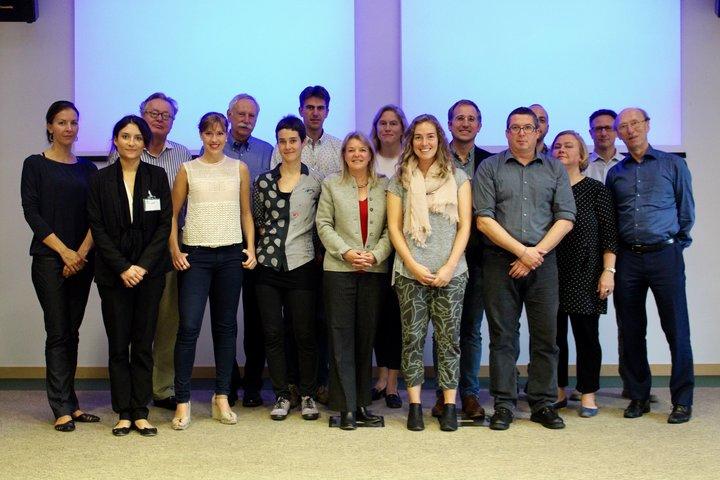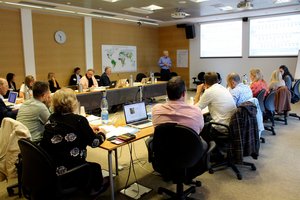Pushing the levers of change that drive how we produce and eat food

EAT, the Stockholm Resilience Centre and CGIAR organized a writeshop at Bioversity International, Rome HQ earlier this month. Interdisciplinary experts set to work to identify the levers of change needed to produce enough nutritious, high quality food in a sustainable and environmentally responsible manner.
Earlier this month, EAT, the Stockholm Resilience Centre and CGIAR organized a writeshop called Healthy People, Healthy Planet: linking diets to food production landscapes.
Over two days, an expert academic group set to work on a daunting challenge — to identify the levers of change needed to produce enough nutritious, high quality food in a sustainable and environmentally responsible manner to feed an ever-increasing population.
The end goal? A position paper that will use a series of case studies to demonstrate some of the principles to be considered when producing a framework for action.
At the opening of the writeshop, Frank Rijsberman, CEO of the CGIAR Consortium commented to the group: “Too often we talk about these issues within silos. It is critical to start thinking about healthy diets from healthy landscapes across various disciplines and across various scales – we have to look beyond the farm field”.
Line Gordon, Associate Professor and Deputy Science Director, Stockholm Resilience Centre, also set the context for the work ahead saying "We are facing enormous health-related dietary challenges, and at the same time we are facing huge planetary sustainability challenges. Food is the driver in both of these, and the homogenization of both landscapes and diets seems to be at the core".
Then it was time for experts from agriculture, aquaculture, nutrition, economics, public health, forest conservation and agroecology to get to work. To help frame the discussion in a multi-disciplinary way, the writeshop started with four presentations, each giving a different expert perspective on the task ahead.
 Walter Willet, Professor of Epidemiology and Nutrition, and Chair of the Department of Nutrition at Harvard School of Public Health, brought home to the group the startling reality that only 10% of crops grown in the US are used directly for food. He highlighted the production of raw materials for ethanol production to drive manufacturing and industry, the large percentage fed to cattle and the processing of maize into high fructose corn syrup: “We could let half the cultivated agricultural land in the US go back to forest and prairie and be massively better off in health and in well-being”. He also stressed that agriculture geared to growing nutritious, diverse foods often generates environmental benefits as well as health ones.
Walter Willet, Professor of Epidemiology and Nutrition, and Chair of the Department of Nutrition at Harvard School of Public Health, brought home to the group the startling reality that only 10% of crops grown in the US are used directly for food. He highlighted the production of raw materials for ethanol production to drive manufacturing and industry, the large percentage fed to cattle and the processing of maize into high fructose corn syrup: “We could let half the cultivated agricultural land in the US go back to forest and prairie and be massively better off in health and in well-being”. He also stressed that agriculture geared to growing nutritious, diverse foods often generates environmental benefits as well as health ones.
The environmental benefits that sustainable food production could bring was echoed by the second presenter, Fabrice DeClerck, Senior Scientist, Agroecology, Bioversity International: “If you can translate dietary diversity to landscape diversity, this can bring strong environmental benefits through the multi-functionality that biodiversity brings to the food production system. It is all connected. It’s not a case of ‘least harm’ to the environment, but actually harnessing its potential to produce food in a healthy, sustainable way. There is not a single driver to this change – it will come from market forces, legislation and personal motivations of both the farmer and the consumer”.
Albert Norström, Executive director, Programme on Ecosystem Change and Society, Stockholm Resilience Centre, talked about the importance of sustainable seascapes for food production. He drew attention to the potential role of key actors within fisheries who greatly influence governance processes and institutions to exhibit large scale changes in the way we procure and process seafood, but that this would require market support. He cited the case of WalMart, who in 2006, announced that it would only purchase its wild-caught fresh and frozen fish for the US market from Marine Stewardship Councils (MSC) fisheries. When considering levers of change, he reminded the group that trade can drive change more than governments.
The last presentation brought an economic lens to what drives change. Professor Ruerd Ruben, Research Coordinator Food Security, Value Chains & Impact Analysis at LEI-Wageningen University made this simple but effective point: "The biggest driver of change to the way we produce and eat food is the motivation of food industries to guarantee continuous deliveries to markets". He cited the example of a farmers' field school training program set up by Unilever in Kenya that provides producers the abilities for improved pruning and improved selection of quality tea leaves. “This then pays off for the company at the market as quality is improved and consistency of the product is guaranteed, and the consumer will continue to buy".
The group then worked together to flesh out a framework for the paper, coming back to report to plenary and agree the way forward. One area that stimulated a lot of discussion how to adapt approaches for solutions in terms of different scales – from the local to the global food system, noting the importance of context – for example, considerations around imports, exports and self-sufficiency of food supply.
Victoria Bignet, Head Coordinator, EAT Science and Competence/Advisory Board, Stockholm Resilience Centre, set the challenge to the group to work towards a launch of the paper at the EAT Stockholm Food Forum 2016 which will be held in June.
Closing the writeshop, Line Gordon summed up the 2 days: “I am very impressed at how far we have come in just two short days, and how much agreement we have, especially when you consider the different expert viewpoints around the table. I think we are seeing a new enlightenment of our dependence on the biosphere and that business as usual is no longer possible. I hope this will translate into positive changes in the areas of research, policy, raising awareness, keystone actors and certification, and that this paper will help with identifying how these changes can happen”.
Read the background paper:
Healthy People, Healthy Planet: Linking diets to food production landscapes
Notes:
This 2-day writeshop was held at Bioversity International HQ, Rome, Italy on 12-13th October, supported by CGIAR and EAT. Participants included:
- Albert Norström, Stockholm Resilience Centre
- Aman Sidhu, Bioversity International (facilitator)
- Fabrice DeClerk, Bioversity International
- Frank Rijsberman, CEO, CGIAR Consortium
- Gina Kennedy, Bioversity International
- Giulia Rota Nodara, Bioversity International (support)
- Guy Henry, International Center for Tropical Agriculture
- Hannah Gentle, Bioversity International
- Ingrid Sarlov-Herlin, Department of Landscape Architecture, Planning and Management
- James Garrett, International Food Policy Research Institute
- Joern Fisher, Leuphana Universität Lüneburg
- Lindsey Hook, Bioversity International (support)
- Line Gordon, Stockholm Resilience Centre
- Roseline Remans, Earth Institute Columbia University/Consultant, Bioversity International
- Ruerd Ruben, Wageningen University
- Selma Gicevic, Harvard T.H. Chan School of Public Health (observer)
- Terry Sunderland, Center for International Forestry Research
- Victoria Bignet, Stockholm Resilience Centre
- Walter Willett, Harvard T.H. Chan School of Public Health
Photo 1: Participants in a group photo at the writeshop.
Photo 2: Walter Willet presents to the participants.
Credit: Bioversity International/L. Hook
